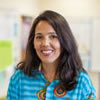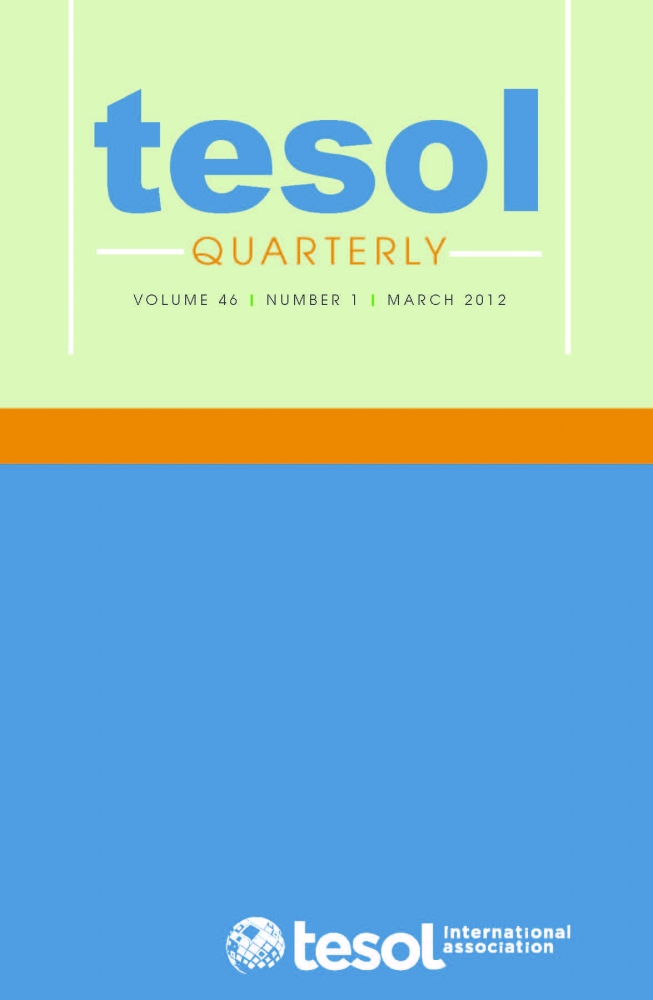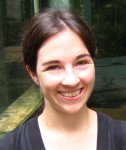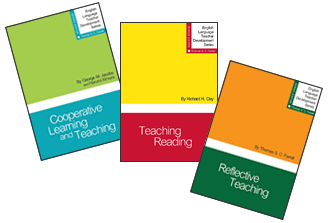Culturally Responsive Teaching
Interview of Robert Sautter & Lhisa Almashy by Tomiko Breland
|

Robert Sautter works with one of his Kindergarten students.
|
TESOL recently interviewed two of the 2012 Culturally Responsive Teaching Award winners. Robert Sautter, Kindergarten teacher in San Francisco, California, United States, and Lhisa Almashy, high school ESOL teacher in Lake Worth, Florida, United States share their views on what it means to be a culturally responsive teacher and how this teaching influences the content they choose, the classroom atmosphere they create, and the relationships they build with students and families. Robert and Lhisa won the award for demonstrating excellence in teaching students from diverse racial, ethnic, and cultural backgrounds.
|

Responses from Robert Sautter are in blue.
| |
|

Responses from Lhisa Almashy are in green.
| |
What is your definition of “culturally responsive teaching”?
|
Robert: As a first and most basic step, a teacher has to cultivate a deep and authentic knowledge of one’s students (and from my perspective as a kindergarten teacher, their families) as well as—and this is important—oneself. This means developing relationships with students and their families; attending community events, conducting home visits; doing whatever it might take to demonstrate through action that you are committed to your students’ success. An important component is knowing who you are and what biases you bring to your interactions with students and families. Particularly when there are differences in culture between teacher and family, it is important for you, the teacher, to examine how you might be perceived; that is, consider how your own experience of the educational system might be similar to or different from the experience of your students/families—and then ask yourself why! Answering with honest self-reflection will invariably lead you to deepening your practice as a culturally responsive teacher. |
|
Lhisa: My definition of “culturally responsive teaching” is to instruct students using their own backgrounds and “cultures” as a vital resource. In order to do this, one needs to understand that the true definition of culture goes far beyond race and ethnicity. It includes all of the surface and deep values that each individual possesses that guides their life and motivates their actions. Therefore, it is imperative that teachers get to know their students as individuals and learn about some of these values. This can take time, but every day one can learn something about someone. One way I learn about my students at the beginning of each year is to establish a social contact with them. Instead of giving them rules, I have them create the class culture or class climate themselves. I am one vote among them. In facilitating this, I can give opposite or hypothetical situations for them to debate possibilities and learn about how they think. This also lends itself to understanding their different learning styles which also helps guide instruction. Ultimately, being a culturally responsive teacher means making the content we teach relevant to the student. It gives them a connection to the real world…or their world as they see it. |
Can you give an example of how you include cultural awareness in your content?
|
Robert: My young kindergartners are keen observers of the differences that exist between one another—so I provide many and varied opportunities to discuss their insights, being certain to frame them as no more and no less than what they are: differences. Additionally, I facilitate a respect for and an understanding of differences by selecting, for example, high quality, culturally relevant children’s literature by diverse authors. Thoughtfully chosen books provide opportunities to challenge stereotypes as well as expand students’ knowledge of continents, countries, and cultures from which their own communities (and classmates) come. Great books become portals into a world of rich discussion so that we begin to understand the differences we observe between cultures or peoples as something that just is. As a concrete example, we use the linguistic variations within our own classroom and incorporate the children’s home language greetings into our community circle each morning. |
|
Lhisa: There are many ways to include cultural awareness in your content; my example uses ethnicity. In teaching “Romeo and Juliet” in my high school English class, I begin by introducing the idea of loyalty and friendship. Because we need language to engage the content and content to engage language, I incorporate oral/aural activities consistently. We begin through small cooperative learning groups, establishing what words like loyalty, friendship, respect and duty look like in the students’ lives and how they feel about them. This is their anticipatory set that allows them a frame of reference for their character analysis. After we have read and processed the play, the project is for each student to create a “Romeo and Juliet” set in his or her home country. Their stories need to parallel Shakespeare’s story and they have to make sure that the families are two different/contrasting entities. Then, they have to present their stories, which educates the rest of the class on the values of the different countries. Through these differences, we see that the “human” components are the same, which ultimately connects us all. |
How do you establish an atmosphere of inclusion in your classroom?
|
Robert: When my students enter our classroom, they know they are loved and that they are an integral part of our community because I greet each child with words, a handshake, and a gentle touch on the shoulder. Physically creating a bond through touch ensures that each child knows—indeed feels—that his presence is recognized by me and that she is valued by our community. We honor the community we have created as we begin each day in community circle. Children greet one another by name, using their home languages. We celebrate our diversity by singing our good morning song in the languages represented by the students, taught to us by the children or by family members. Moreover, my children know they always have opportunities to shine because I use rotations for special jobs, equity sticks in place of raising hands, and structured language and response protocols that access the various communication preferences of my students. |
|
Lhisa: I establish an atmosphere of inclusion in my classroom primarily through cooperative learning groups. Each student in the group is assigned a role: scribe, messenger or quality controller. They can then rotate positions and help each other with the content and daily activities. In my World History class during the Feudalism unit, I had each student choose a social status out of a hat; this mirrored how people were born into a certain class (nobility, clergy, peasantry, etc.) and could not change it. If someone needed anything, be it a bathroom pass or a question with the content, he or she had to follow the feudalistic chain. The students took their responsibilities seriously and really tried to have the best group, or fiefdom, in the kingdom! These kinds of activities differentiate instruction and give all students the opportunity to succeed while maintaining the rigor of the course. |
How can teachers relate teaching content to the cultural backgrounds of their students if their students come from diverse backgrounds?
|
Robert: I strive to create the kind of classroom where every child’s individual strengths are known well and used well by me in the service of culturally responsive, differentiated instruction. The degree to which I am successful in adapting my instruction depends upon the relationships I develop and the extent to which I recognize my students as individuals located within their particular contexts. Therefore, I strive to create opportunities to know each of my students better. For example, during the first weeks of school I have individual story time wherein each child chooses a short book to read and discuss with me; in this way, we establish a connection through literacy. Home visits provide the chance for me to establish a trusting relationship and to learn more about my students’ traditions, values, histories, and languages. When I am invited into a student’s home, the purpose is not so much to become informed as it is to experience—if ever so briefly—what it is like to be my student, in his or her context. With these experiences I am better able to be the kind of teacher that each child needs me to be for his or her specific needs. |
|
Lhisa: It’s important for teachers not to lose sight of the fact that teachers service people, not products or test scores. In remembering each student’s humanity, we need to connect the purpose or objectives that we teach to students’ ways of viewing the world. Instead of seeing this diversity as an obstacle, choose to see it as a rich resource to use, just as we would a teacher’s edition. Making connections and dialogue is the gateway to understanding. |
In what way are parents involved in culturally responsive teaching?
|
Robert: Just as each student is unique, so too is her family; therefore, no single approach to partnership-creation prevails in my racially, linguistically, and socio-economically diverse classroom. With an open and friendly relationship established, I can honor my families as experts on not only their children but also their home cultures through invitations, for example, to help us learn our Good Morning Song in their home languages. A culturally responsive teacher creates opportunities to ensure that the expertise of a family is highlighted in the classroom. |
|
Lhisa: Parents are involved in culturally responsive teaching through helping explain, when possible, how they “do things” or what the family may be used to. One of the greatest challenges in teaching continues to be parental involvement. I like to make phone calls to all the families at the beginning of the year to touch base; this way, the families know and understand my philosophy. I, too, can gain an understanding of the home life a little more to enable me to better serve the individual needs of my students. For teachers who serve 200 plus students, this is more difficult. I like to have several separate meetings a year with my parents, called a Parent Leadership Council. The students can showcase their work and we can provide important information to the parents, while showing them that they are encouraged to participate in the school and their child’s education. |
What evidence do you receive from students that your cultural lessons are being put into practice?
|
Robert: I know that I am being a successful culturally relevant teacher when I observe the blossoming of a true “community” amongst my young students. With the scaffolding that I provide, students become the builders of their classroom community as well as its caretakers. Framing “community” as “people who respect one another as they work together”—and relating this concept to what they already understand best: their families—my students begin to understand that people are interdependent. Starting each day in community circle, greeting one another by name using the languages spoken at home, allowing a “student-of-the-day” to read a daily affirmation that the community repeats and discusses briefly are powerful ways to build trust and commitment to one another. The trust that we create becomes manifest in the ability to discuss topics with one another according to the protocols that we developed for having a respectful conversation at school. |
|
Lhisa: The evidence includes observation, graduation rates, and academic achievement as quantitative measurements. As qualitative or anecdotal evidence, students often return and tell me how they are living their lives or how they encountered a situation and because of a lesson they learned in my class, they were able to handle it in a productive way. The best evidence is when I see how more senior students help and mentor newer students. My bottom line for the students is and will always be that they become productive, responsible people who are able to balance the best from the people they meet, represent themselves as cultural ambassadors to help educate people through their example, and remember to validate the human dignity in all people. |
The Culturally Responsive Teaching Awards were created and are administered by the Southern Poverty Law Center’s Teaching Tolerance project. Read about and watch videos of all five winners here.
____________________
Lhisa Almashy, a graduate of the University of San Francisco, is an ESOL teacher at Park Vista High School in Lake Worth, Florida, USA. She has been teaching and administering multicultural programs in her school district for more than 16 years.
Robert Sautter is an equity-driven National Board Certified kindergarten teacher who cares about the children in his classroom community both as students and as individuals living within particular cultural, historical, and linguistic contexts. He endeavors daily to learn from his students and their families about how to serve them to the best of his abilities so that every child has the opportunity to shine brilliantly every day.
Photo headshots courtesy of Teaching Tolerance, credit Todd Bigelow (Sautter); Dan Chung (Almashy).
TC Monthly Giveaway Congratulations to Gerardo Chavez of Chiapas, Mexico, for being the winner of the March 2013 TESOL Connections Monthly Giveaway. Gerardo won a free English Language Teacher Development book set.
This month, TESOL is giving away a free subscription to
TESOL Quarterly!

TESOL Quarterly is a refereed professional journal that fosters inquiry into English language teaching and learning by providing a forum for TESOL professionals to share their research findings and explore ideas and relationships in the field.
Click here to enter
Drawing closes 28 April 2013, 11:59 pm EST
TESOL Blogs Interested in writing a blog for TESOL?
Contact Tomiko Breland with your idea or for details.
Check out the latest TESOL Blogs:
|
The Language Pill, Perpetual Toothbrushes, and Other Whimsical Inventions, by Alexandra Lowe
 Do you have certain communicative activities that you find work no matter what level you are teaching? Are there activities that you can always turn to when the energy in the classroom starts to flag? Do you have certain communicative activities that you find work no matter what level you are teaching? Are there activities that you can always turn to when the energy in the classroom starts to flag?
In this regard, I wanted to share with you an activity that Irina Climovici, a colleague from SUNY Westchester Community College, taught me last year and that has stood me in good stead ever since. I used it last week when it became apparent that my Level 5 evening students, who had enthusiastically debated the merits of investing in derelict buildings in Detroit and had written at length about the impact of the Great Recession on their own lives, were running out of steam as the clock ticked toward 9 p.m. Read More. |
|
From the Perspective of a Student, by Tara Arntsen
 Since I am advocating for teaching using technology, I would like to note that I have also studied extensively online using all sorts of technology. While it is not the same as integrating technology into traditional classroom-based lessons, I wanted to share these experiences with you anyway, mostly as proof that online learning is still real learning. My best experiences studying online have been with the University of Southern California and Udacity. Read More. Since I am advocating for teaching using technology, I would like to note that I have also studied extensively online using all sorts of technology. While it is not the same as integrating technology into traditional classroom-based lessons, I wanted to share these experiences with you anyway, mostly as proof that online learning is still real learning. My best experiences studying online have been with the University of Southern California and Udacity. Read More.
|
|
TESOL 2013 Graduate and Doctoral Student Forums Combine for Memorable Day, by Elena Andrei
 The TESOL Graduate Forum and the TESOL Doctoral Forum are wonderful one-day events usually held the Wednesday before the TESOL Annual Convention & English Language Expo. If you are a graduate student in TESOL, ESL/EFL, or applied linguistics, I would encourage you to attend. The TESOL Graduate Forum and the TESOL Doctoral Forum are wonderful one-day events usually held the Wednesday before the TESOL Annual Convention & English Language Expo. If you are a graduate student in TESOL, ESL/EFL, or applied linguistics, I would encourage you to attend.
At TESOL 2013, the Doctoral and Graduate Forums joined talents and forces. We had a great event in which students were involved in vibrant discussions about teaching, researching, and learning in the TESOL field.
One highlight of the day.... Read More. |
TESOL Bookstore

NEW!
Language Teacher Development Series
Thomas S. C. Farrell, series editor

Perfect for MA Programs, Skills Courses, ESL, EFL, EIL, and ESOL Classrooms:
Toll Free: 888-981-0041
E-mail: tesol@brightkey.net
|
 |
|
|
 |
| English Language Fellow Program, U.S. Department of State, USA
Director, English Language Institute (IEP), The University of Akron, Akron, Ohio, USA
Assistant Professor, Alliant International University, San Diego, CA, USA
Worldwide Fellowships Available, English Language Fellowship Program, USA
Assistant/Associate Professor Faculty Positions, Faculty of Communication, Nagoya University of Commerce & Business, Japan
Elementary Teacher, Northridge School, Mexico City, Mexico
Postdoctoral Scholar, Center for English as a Second Language, University of Kentucky, Kentucky, USA
Teach ESL Internationally on U.S. Embassy Projects, English Language Fellow Program, U.S. Department of State, USA
Want to post your open positions to Job Link? Click here.
To browse all of TESOL's job postings, check out the TESOL Career Center. |
 |
|
 |
| ADVERTISEMENT |

|
 |
|